Attention: Changes Going into Effect July 1, 2023
Per RMA bulletins Product Management Bulletin: PM-23-022*, revisions were made to the Livestock Gross Margin (LGM), Livestock Risk Protection (LRP) and Dairy Revenue Protection (DRP) plans of insurance for 2024 and succeeding Crop Years (CY).
LRP Changes:
- Modified the end of the sales period to 8:25 AM Central Time; and
- For LRP-Fed Cattle, modified the price series to “Over 80% Choice.”
Livestock Risk Protection (LRP) program protects livestock producers against a general market decline while letting them take advantage of a rising market. LRP is a simple and cost effective way of establishing a minimum price floor for your livestock.
Livestock Risk Protection limits the downside of the market while allowing unlimited profit potential. The timing of when you plan to market your cattle will determine your coverage period, price, and target ending weight.
Coverage is available for:
How LRP Works
A producer must submit an LRP policy application through an authorized crop or livestock insurance vendor. Insurance vendors must have completed an RMA training program to become authorized. The application process establishes a producer’s eligibility by documenting his or her substantial beneficial interest in the cattle. A producer with a partial interest in a group or pen of cattle may independently insure his or her portion. After completing the policy application, producers select a coverage price and endorsement length that meets their risk management objectives. This information may change daily and is posted on the RMA website.
The coverage price is a percentage of the expected ending value. This value and the associated rates are based on the current day’s closing futures prices, volume and volatility; they correspond to separate endorsement lengths. The difference between the expected ending value and the coverage price is similar to the deductible on an auto insurance policy. A larger deductible (a lower coverage price relative to the estimated ending value) corresponds to a lower premium.
Endorsement lengths are in increments of about 30 days from 13 to 52 weeks. Both feeder cattle and fed cattle producers will want to purchase price risk insurance with an ending date of coverage that meets their risk management objectives. Feeder cattle producers may want the end date of coverage to match the expected date the cattle will be sold or moved to a feedlot. Fed cattle producers, on the other hand, will want to match the ending date of coverage with the anticipated date the cattle will be ready for slaughter. Both policies, however, can be purchased with shorter endorsement lengths.
LRP coverage does not begin until a Specific Coverage Endorsement (SCE) is submitted and accepted by RMA. The submission of the SCE to the RMA is done online after the application has been accepted. The SCE specifies the elected coverage price, the specific number of head covered, and the length of coverage. LRP policies require that sales be allowed from the time rates are set and validated (based on the current day’s CME prices) to 9:00 a.m. Central time the following day. Once the SCE is accepted, the coverage is in place and a premium is due. If, at the ending date of coverage, the Actual End Value has dropped below the selected coverage price, the producer can claim an indemnity but must file for it within 60 days. The indemnity will be paid whether or not the cattle were sold by the ending date of coverage. However, selling the cattle more than 30 days before the end of coverage will terminate the policy unless the insurance provider has specifically approved the sale. Cattle seized, quarantined, destroyed or not salable because of death or disease will still be covered by the policy if written notice of the circumstances is provided within 72 hours.
It is crucial for producers to understand that the ending value of the LRP contract is not the cash price received or a closing futures price as of the end date of the policy. The LRP-Feeder Cattle policy uses the Chicago Mercantile Exchange (CME) feeder cattle price index as the actual end value. This cash-settled commodity index is a mathematical calculation that averages the headcounts, weights and prices from numerous livestock sales across the nation to determine its settlement price. The LRP-Fed Cattle policy uses a weekly weighted average of the slaughter cattle prices in five areas as reported by the Agricultural Marketing Service (AMS).
Livestock Risk Partners provides risk protection for livestock producers. We offer insurance products that provide margin protection or protect from price decline.
Keeping livestock farms profitable to keep our communities strong is what we do!



